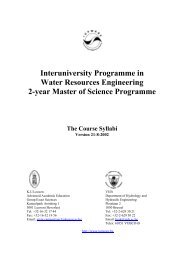CFHT operating manual - Homepage Usask
CFHT operating manual - Homepage Usask
CFHT operating manual - Homepage Usask
You also want an ePaper? Increase the reach of your titles
YUMPU automatically turns print PDFs into web optimized ePapers that Google loves.
ESPaDOnS: thermal response and spectral stability http://webast.ast.obs-mip.fr/magnetisme/espadons_new/stability.html<br />
ESPaDOnS<br />
Thermal response and spectral stability<br />
General concept<br />
To ensure that ESPaDOnS would be as stable as possible, we decided to follow the advice of the Geneva experts for improving<br />
the stability of echelle spectrographs. Without going to the extremes of enclosing the entire spectrograph within a depressurised<br />
and thermally regulated container (eg as was done for harps, the eso spectrograph dedicated to ultra high precision<br />
measurements of stellar radial velocities and mounted on the la silla 3.6m telescope), we converged towards an intermediate<br />
solution involving a double-layer thermal insulation. The concept (recommended by the Geneva experts) features:<br />
an inner thermally-passive enclosure in which the spectrograph table (and optical and mechanical components<br />
mounted on it) are included;<br />
an outer thermally-active enclosure containing the inner enclosure and in which the temperature is regulated at an<br />
accuracy of about 0.1deg.<br />
This ensures in particular that the temperature within the spectrograph is stable to a rms level of a few 0.01deg, provided that<br />
operations within the inner enclosure are kept to an absolute minimum. For both scheduling and practical reasons, it was<br />
decided that only the inner enclosure is built while ESPaDOnS is at OMP, while the outer enclosure and thermal regulation is<br />
implemented in a second step, once ESPaDOnS is installed in the coude room of cfht.<br />
Accurate temperature sensors (with a precision of 0.01deg) are implemented at different points within the inner enclosure to<br />
check the stability and estimate potential temperature drifts and gradients. A digital barometer is also implemented within the<br />
inner enclosure to monitor pressure fluctuations at the 0.01mbar level. To minimise operations within the inner enclosure, the<br />
ccd filling and exhaust pipes are installed permanently and are thermally insulated (within an evacuated tube) from the inner<br />
spectrograph environment.<br />
Performance of inner enclosure<br />
The graph on the right shows the room temperature (full line)<br />
along with the temperature within ESPaDOnS inner enclosure<br />
(dashed line), as recorded in a long test run of several weeks<br />
during which the enclosure was kept closed as much as<br />
possible. This graph shows the temperature variations during<br />
about four consecutive days, where daily fluctuations in outside<br />
temperature (with a peak-to-peak amplitude of about 1deg) are<br />
clearly visible.<br />
This demonstrates that the inner enclosure smoothes out all<br />
short term temperature variations by at least an order of<br />
magnitude. In particular, daily changes are no longer<br />
detectable within the spectrograph. However, longer term<br />
variations (on a timescale of several days) are still present and<br />
essentially mimic (as expected) the long term fluctuations in<br />
outside temperature.<br />
Spectrograph temperature variations of as much as 0.7deg/d<br />
are observed in the present context; they should be reduced by<br />
at least a factor of 2 once ESPaDOnS is installed at <strong>CFHT</strong>, where temperature drifts in the coude room are typically of order<br />
0.1degr/d and rarely exceed 0.3deg/d. Once the outside enclosure and thermal regulation is setup, such drifts should be further<br />
reduced by typically an order of magnitude on timescales of days.<br />
1 of 2 08/07/04 11:30 PM

















